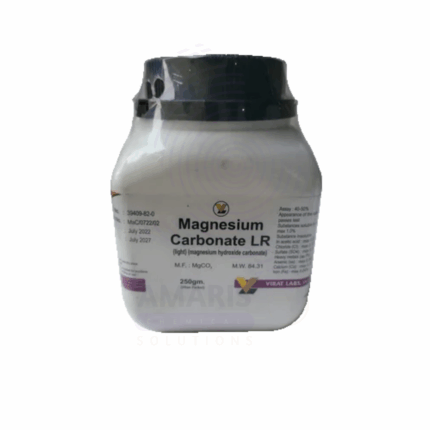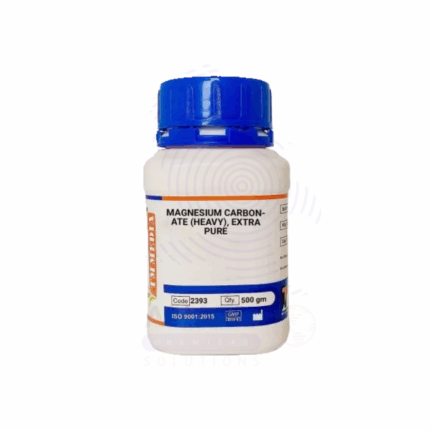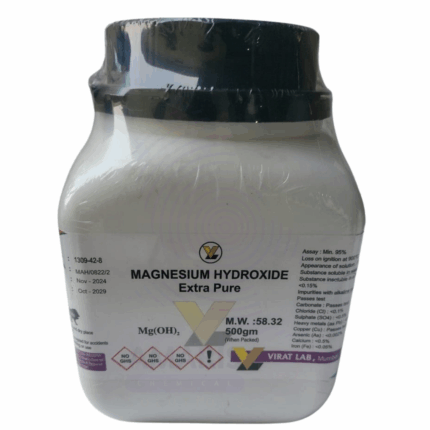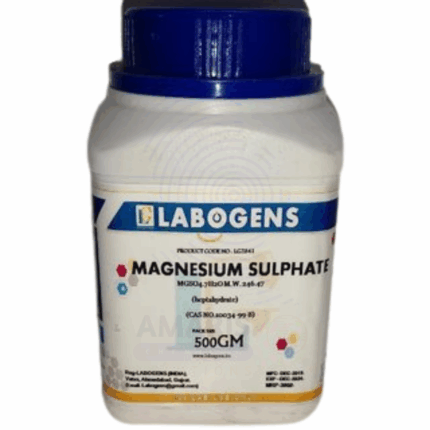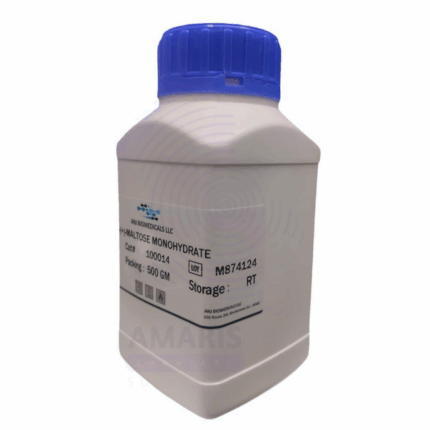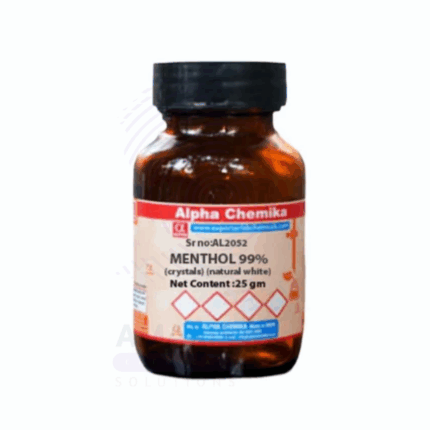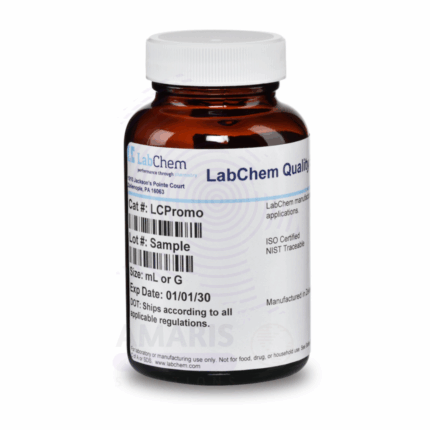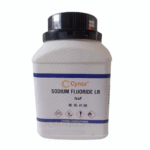

Sodium Formate Extra Pure
$ 15.79 Original price was: $ 15.79.$ 15.67Current price is: $ 15.67.
Sodium Formate Extra Pure is a white crystalline powder known for its high purity and excellent solubility in water. It is extensively used as a buffering agent and mild reducing agent in laboratory and pharmaceutical applications. Industrially, it plays a significant role in leather tanning, corrosion inhibition, textile dyeing, and environmentally friendly de-icing formulations. Its versatility extends to agricultural, environmental, food, cosmetic, and cleaning industries, making it a valuable compound for diverse chemical processes. Proper storage in sealed containers away from moisture and acids is critical to preserve its quality and stability.
Sodium Formate Extra Pure
PRIMARY USES
- Analytical Reagent & Laboratory Applications:
Used as a buffering agent to maintain pH stability in chemical and biochemical assays
• Employed in preparation of standard solutions, calibration buffers, and titrations
• Acts as a reducing agent in organic and inorganic synthesis reactions
• Used in protein crystallization and other biochemical research protocols - Pharmaceutical & Chemical Manufacturing:
Serves as an intermediate in the synthesis of pharmaceuticals and preservatives
• Used in production of formic acid derivatives and other fine chemicals
• Acts as a stabilizer and preservative in certain pharmaceutical formulations - Industrial Applications:
Widely used in leather tanning as a masking agent to improve dye uptake and reduce chromium toxicity
• Functions as a corrosion inhibitor in metalworking fluids, cooling systems, and oilfield drilling fluids
• Used in textile dyeing and printing to enhance color fixation and reduce environmental impact
• Applied in the production of de-icing agents and environmentally friendly anti-icing formulations
• Serves as a component in concrete admixtures to improve setting and durability - Agricultural Uses:
Used as a component in some pesticide formulations as a buffering and stabilizing agent
• Acts as a soil pH adjuster and conditioning agent to improve nutrient availability - Food Industry:
Occasionally used as a food additive (E237) for pH regulation and preservation in certain food products, under regulatory control
SECONDARY USES
- Environmental Applications:
Used in wastewater treatment to neutralize acids and reduce heavy metal contamination
• Acts as a chelating agent for metal ions in environmental remediation processes - Research & Development:
Utilized in laboratory synthesis and experimental chemistry requiring a mild reducing agent
• Used in biotechnological applications including enzyme stabilizations and buffer systems - Cosmetic Industry:
Occasionally included in cosmetic formulations as a pH adjuster and preservative stabilizer - Cleaning & Detergent Industry:
Used in specialty cleaning formulations for metal surfaces due to its mild alkalinity and chelating properties - Textile Industry:
Employed in dye fixation and to improve fastness of colors on fabrics
• Helps in reducing environmental impact of dye wastewater by chelating metal ions - Water Treatment:
Used to buffer pH and act as a corrosion inhibitor in potable water and cooling water systems
1. Basic Identification Attributes
- Chemical Name: Sodium Formate
• CAS Number: 141-53-7
• HS Code: 2915.11.00
• Molecular Formula: HCOONa (monohydrate or anhydrous forms; Extra Pure typically monohydrate or anhydrous)
• Synonyms:
- Sodium methanoate
- Formic acid sodium salt
2. Physical & Chemical Properties
Physical State: Solid (white crystalline powder or granules)
• Color & Odor: White, odorless or faint vinegar-like odor
• Melting Point: Decomposes around 253 °C
• Density/Specific Gravity: ~1.44 g/cm³
• Solubility:
- Highly soluble in water (~97 g/100 mL at 20 °C)
- Insoluble in ethanol and ether
• pH Level: Mildly alkaline in aqueous solution
• Vapor Pressure & Volatility: Negligible
• Flash Point: Not applicable (non-flammable)
3. Safety & Hazard Attributes
Hazard Class (GHS Classification):
- May cause skin and eye irritation (Category 2)
• NFPA Ratings: - Health: 1
- Flammability: 0
- Reactivity: 0
• Exposure Limits: - No specific OSHA PEL or ACGIH TLV established
• Reactivity: - Stable under normal conditions
- Reacts with strong acids releasing formic acid fumes
4. Storage & Handling Attributes
Storage Conditions:
- Store in a cool, dry, and well-ventilated place
- Keep container tightly closed
• Incompatible Materials: - Strong oxidizers and acids
• Container Type: - Plastic, polyethylene, or glass containers with secure sealing
• Shelf Life & Expiration Date: - Stable for several years if stored properly
• Special Handling Requirements: - Avoid dust formation
- Use protective gloves and goggles
5. Regulatory & Compliance Attributes
Regulatory Status:
- Approved for industrial and laboratory use
- Listed on chemical inventories such as REACH and EPA
• Transportation Restrictions: - Not classified as hazardous for transport
• Waste Disposal Method: - Dispose of according to local environmental regulations
- Non-hazardous waste classification
6. Environmental & Health Impact
Ecotoxicity:
- Low toxicity to aquatic life
• Persistence in Environment: - Biodegradable in the environment
• Carcinogenicity/Mutagenicity: - Not classified as carcinogenic or mutagenic
• Biodegradability: - Biodegradable
SAFETY PRECAUTIONS
Personal Protective Equipment (PPE):
• Wear chemical-resistant gloves
• Use safety goggles or face shield
• Wear protective clothing
• Use dust mask or respirator if dust exposure is likely
Handling:
• Avoid inhalation of dust
• Handle in a well-ventilated area
• Wash hands thoroughly after handling
Storage:
• Store in tightly sealed containers
• Keep away from moisture, acids, and oxidizers
FIRST AID MEASURES
Inhalation:
• Move to fresh air immediately
• Seek medical attention if breathing difficulty occurs
Skin Contact:
• Wash skin with soap and water
• Remove contaminated clothing
• Seek medical attention if irritation develops
Eye Contact:
• Rinse eyes thoroughly with water for at least 15 minutes
• Seek medical attention if irritation persists
Ingestion:
• Rinse mouth with water
• Do not induce vomiting unless advised by medical personnel
• Seek medical attention if symptoms appear
FIRE FIGHTING MEASURES
Flammability:
• Non-flammable solid
Extinguishing Media:
• Use water spray, foam, dry chemical, or CO₂
Hazardous Combustion Products:
• May emit carbon monoxide, carbon dioxide, and formic acid vapors under fire conditions
Firefighter Protection:
• Use self-contained breathing apparatus (SCBA) and full protective gear


 Preservatives(food)
Preservatives(food) Flavor Enhancers
Flavor Enhancers Acidulants
Acidulants Sweeteners
Sweeteners Antioxidants
Antioxidants Colorants(food)
Colorants(food) Nutraceutical Ingredients (food)
Nutraceutical Ingredients (food) Nutrient Supplements
Nutrient Supplements Emulsifiers
Emulsifiers
 Collectors
Collectors Dust Suppressants
Dust Suppressants Explosives and Blasting Agents
Explosives and Blasting Agents Flocculants and Coagulants
Flocculants and Coagulants Frothers
Frothers Leaching Agents
Leaching Agents pH Modifiers
pH Modifiers Precious Metal Extraction Agents
Precious Metal Extraction Agents
 Antioxidants(plastic)
Antioxidants(plastic) Colorants (Pigments, Dyes)
Colorants (Pigments, Dyes) Fillers and Reinforcements
Fillers and Reinforcements Flame Retardants
Flame Retardants Monomers
Monomers Plasticizers
Plasticizers Polymerization Initiators
Polymerization Initiators Stabilizers (UV, Heat)
Stabilizers (UV, Heat)
 Antifoaming Agents
Antifoaming Agents Chelating Agents
Chelating Agents Coagulants and Flocculants
Coagulants and Flocculants Corrosion Inhibitors
Corrosion Inhibitors Disinfectants and Biocides
Disinfectants and Biocides Oxidizing Agents
Oxidizing Agents pH Adjusters
pH Adjusters Scale Inhibitors( water)
Scale Inhibitors( water)
 Antioxidants(cosmetic)
Antioxidants(cosmetic) Emollients
Emollients Fragrances and Essential Oils
Fragrances and Essential Oils Humectants
Humectants Preservatives
Preservatives Surfactants(cosmetic)
Surfactants(cosmetic) Thickeners
Thickeners UV Filters
UV Filters
 Fertilizers
Fertilizers Soil Conditioners
Soil Conditioners Plant Growth Regulators
Plant Growth Regulators Animal Feed Additives
Animal Feed Additives Biostimulants
Biostimulants Pesticides (Herbicides, Insecticides, Fungicides)
Pesticides (Herbicides, Insecticides, Fungicides)
 Active Pharmaceutical Ingredients (APIs)
Active Pharmaceutical Ingredients (APIs) Excipients
Excipients Solvents(pharmaceutical)
Solvents(pharmaceutical) Antibiotics
Antibiotics Antiseptics and Disinfectants
Antiseptics and Disinfectants Vaccine Adjuvants
Vaccine Adjuvants Nutraceutical Ingredients (pharmaceutical)
Nutraceutical Ingredients (pharmaceutical) Analgesics & Antipyretics
Analgesics & Antipyretics
 Analytical Reagents
Analytical Reagents Solvents(lab)
Solvents(lab) Chromatography Chemicals
Chromatography Chemicals Spectroscopy Reagents
Spectroscopy Reagents microbiology-and-cell-culture-reagents
microbiology-and-cell-culture-reagents Molecular Biology Reagents
Molecular Biology Reagents Biochemical Reagents
Biochemical Reagents Inorganic and Organic Standards
Inorganic and Organic Standards Laboratory Safety Chemicals
Laboratory Safety Chemicals Specialty Laboratory Chemicals(Special Laboratory Equipment)
Specialty Laboratory Chemicals(Special Laboratory Equipment)
 Demulsifiers
Demulsifiers Hydraulic Fracturing Fluids
Hydraulic Fracturing Fluids Scale Inhibitors(oil)
Scale Inhibitors(oil) Surfactants(oil)
Surfactants(oil) Drilling Fluids
Drilling Fluids
 Dyes and Pigments
Dyes and Pigments Bleaching Agents
Bleaching Agents Softening Agents
Softening Agents Finishing Agents
Finishing Agents Antistatic Agents
Antistatic Agents
 Admixtures
Admixtures Waterproofing Agents
Waterproofing Agents Sealants and Adhesives
Sealants and Adhesives Curing Compounds
Curing Compounds Concrete Repair Chemicals
Concrete Repair Chemicals Anti-Corrosion Coatings
Anti-Corrosion Coatings
 Surfactants(cleaning)
Surfactants(cleaning) Builders
Builders Enzymes
Enzymes Solvents (Cleaning)
Solvents (Cleaning) Fragrances
Fragrances
 Electronic Chemicals
Electronic Chemicals Catalysts
Catalysts Lubricants
Lubricants Photographic Chemicals
Photographic Chemicals Refrigerants
Refrigerants Automotive chemicals
Automotive chemicals Pyrotechnic Chemicals
Pyrotechnic Chemicals
 Biodegradable Surfactants
Biodegradable Surfactants Bio-based Solvents
Bio-based Solvents Renewable Polymers
Renewable Polymers Carbon Capture Chemicals
Carbon Capture Chemicals Wastewater Treatment Chemicals
Wastewater Treatment Chemicals
 Pigments
Pigments Solvents(paint)
Solvents(paint) Specialty Coatings
Specialty Coatings Binders/Resins
Binders/Resins Additives
Additives Driers
Driers Anti-Corrosion Agents
Anti-Corrosion Agents Functional Coatings
Functional Coatings Application-Specific Coatings
Application-Specific Coatings
 Fresh Herbs
Fresh Herbs Ground Spices
Ground Spices Whole Spices
Whole Spices Spice Blends
Spice Blends Dried Herbs
Dried Herbs
 Leavening Agents
Leavening Agents Dough Conditioners
Dough Conditioners Flour Treatments
Flour Treatments Fat Replacers
Fat Replacers Decoratives
Decoratives Preservatives(baking)
Preservatives(baking)
 Plasticizers & Softeners
Plasticizers & Softeners Reinforcing Agents
Reinforcing Agents Adhesion Promoters
Adhesion Promoters Vulcanizing Agents
Vulcanizing Agents Antidegradants
Antidegradants Blowing Agents
Blowing Agents Fillers & Extenders
Fillers & Extenders Accelerators & Retarders
Accelerators & Retarders


